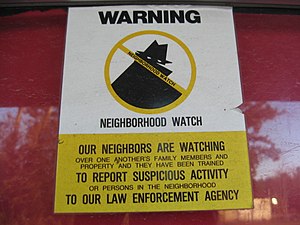There are a number of resources available to remind pet owners what to do in the event of an emergency. Most importantly is the need to prepare. Make sure you have enough pet food and medications if your pet needs them.
See below for other suggestions.
Pet Disaster Safety Checklist
Latest News
Saturday, November 24, 2012
Tuesday, November 13, 2012
Emergency Kit
Take a moment to download the following checklist of what you and your family need to include in your emergency preparedness kit.
Prepare City Emergency Kit
Prepare City Emergency Kit
Friday, November 9, 2012
Tips for Parents
 |
| English: A neighborhood watch sign attached to a door. (Photo credit: Wikipedia) |
Related articles
FEMA Has Toolkit for Business Earthquake Survival
 FEMA has an excellent toolkit for businesses on how to prepare for and mitigate damages caused by an earthquake.
FEMA has an excellent toolkit for businesses on how to prepare for and mitigate damages caused by an earthquake.
If you click here you will find numerous resources to prepare your business. Do it today so that you can stay in business and fully recover after a major earthquake.
Related articles
Thursday, November 1, 2012
American Red Cross Ready Rating Program Helps You Get Prepared
 |
| English: Washington, DC, July 7, 2006 -- A Red Cross "ready to go" preparedness kit showing the bag and it's contents. Red Cross photograph (Photo credit: Wikipedia) |
Preparedness Essentials
The Ready Rating program is designed
to help your business or organization get better prepared for
emergencies. Below are the five cornerstone preparedness actions of the
Ready Rating program. When you join the Ready Rating program, you'll get
access to a detailed Ready Rating Program Guide that guides you through
each of these steps. This condensed version of the Program Guide is
designed to provide a snapshot of how the American Red Cross can help
your business get better prepared.The 123-point Red Cross Ready Rating 123 Assessment tool and Ready Rating 123 Program Guide are the result of a comprehensive review of preparedness recommendations conducted by the American Red Cross National Office of Preparedness and Health and Safety Services, the national Ready Rating team, and the American Red Cross Scientific Advisory Council. All Ready Rating program steps and recommendations are grounded in scientific research, best practices and/or expert opinion from respected professionals representing multiple disciplines and perspectives.
1. Commit to preparedness
This
step indicates your commitment to increasing your business' or
organization’s level of emergency preparedness during the course of the
calendar year. You will be working to make your business or organization
more prepared and to enhance overall community preparedness. Key actions for this step include:
- Having your business or organization make preparedness a priority by having senior leadership involved
- Appointing a Ready Rating liaison dedicated to completing the 123 Assessment
This step involves gathering information about possible emergencies that could impact your business and your facility’s capabilities to respond to and recover from a disaster or other emergency. Key actions for this step include:
- Knowing your region and the types of disasters most likely to impact your business
- Obtaining a Hazard Vulnerability Assessment from your local emergency management agency
- Considering which hazards your facility is most likely to experience, based on proximity and past events
- Knowing your business or organization’s current capacity to prepare for, respond to and recover from a disaster
- Assessing the physical capacity, supplies, equipment and
human resources of your facility to resist damage during a disaster
An emergency response plan describes the steps your business or organization will take to protect your business and employees before, during and after an emergency. Key actions for this step include:
- Identifying an emergency planning committee that is responsible for developing and implementing an emergency response plan
- Developing a written plan describing how your business or organization will respond during a disaster or medical emergency
- Creating a Continuity of Operations Plan (COOP)
This step involves continuing to work with the planning committee to implement the emergency response plan with employees. The key to implementing the plan is to make preparedness a part of the corporate culture. Key actions for this step include:
- Training employees on a regular basis about what to do during a disaster or emergency
- Acquiring and maintaining needed safety equipment and
emergency preparedness supplies - Showing employees how to be prepared at work and at home so they are better equipped to help the business respond to and recover from an emergency
- Conducting and assessing regular drills and exercises to determine the readiness of your employees and facilities
Now that your company and employees are prepared, make at least one additional commitment to ensure that the overall community is prepared for a disaster or other emergency. Key actions for this step include:
- Hosting blood drives
- Contributing supplies and/or services to emergency response efforts
- Adopting a local school or school district and support their disaster and emergency preparedness program
Related articles
Subscribe to:
Posts (Atom)










